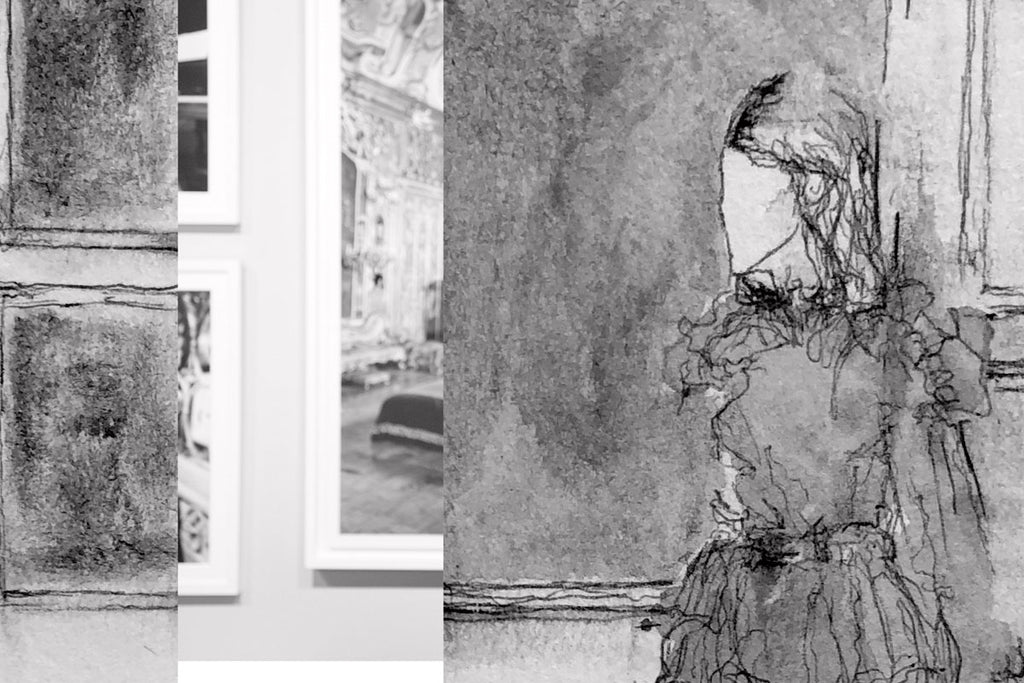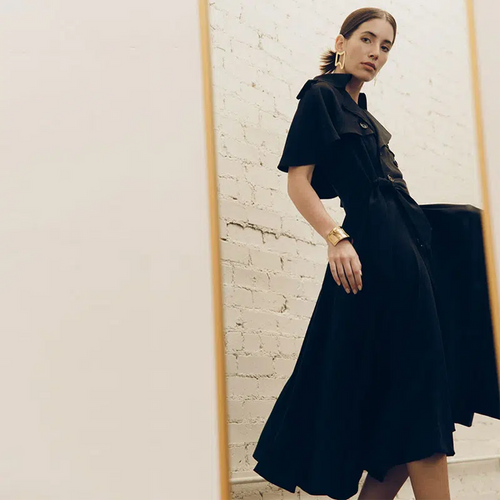
For her inaugural collaboration for Eve & Max, founder Max Trowbridge looked to New York-based artist Ruben Burgess Jr. as a partner. The 28-year-old artist is known for his single-line drawings, which are a feat of physical and mental triumph: Not once during the creation of these works does Burgess lift his pen from the canvas. The continuous-line works, which fall under his aptly named “Sartorialnolift” series, walk a careful balance between perfectionism and vulnerability; they dabble in the space between being beautiful and haunting.
Burgess has long been fascinated by the artistry of the fashion world — and he prefers natural materials over synthetic mediums. For his commission for Eve & Max, which appears on a limited edition, organic cotton shirt, Burgess worked in turmeric and coffee to depict an anonymous woman in an Alexander McQueen-inspired gown, gazing at a work of art. As Eve & Max looks to amplify the synergies between the worlds of fine art and fashion, there could be few more perfect visuals to embody the brand’s creative ethos. Ahead of the launch, we gave Burgess a buzz to discuss everything from his adoration of Rei Kawakubo to his recent experimentation with a tattoo gun, and what quarantine has been like from his home in Brooklyn.
Tell me about how you came to discover your Sartorialnolift practice? I know it started while you were on a train in Paris ...
I recognized [the method] most when I was abroad studying fashion theory. Basically, it was just me sketching in my sketchbook. I had been dragging my pen across the paper, and I drew something in one line. It was a mild shock to the system — like when you try an amazing new food. It was something I couldn’t explain. In the beginning, I was very fashion-driven, drawing my favorite designers, portraits of designers themselves and then portraits of voluminous clothing.

Tell us about the practice of drawing without lifting the pen.
Contour line drawing is a practice for art in general and art students. It’s used to open perspective and open minds. However, this kind of practice became my main medium — and so when I approach a project or a piece, it’s very intuitive. It’s not pre-planned. I have a reference or inspiration photo that catches my eye, then I’ll take a couple breaths and go from there. It’s all about feeling. It’s all about flow. One line to the next. It’s something that literally flows out as it’s being drawn. I like the concept of the mind being able to complete the work. There are a lot of non-connecting moments within the drawing that are connected by the flow of the line.
It seems symbolic in many ways: the idea that the pen never leaves paper.
There is a connectivity between the lines and the art of allowing things to happen — the art of allowing things to unfold. It’s definitely present in this practice. I’ve got to have that trust. I tend to drift toward the darker end of the spectrum in terms of the subject matter. Whatever the classical form of beauty is in art, I tend to go to the darker side of things. That being said, I really enjoy the delicate line as well. There’s this back and forth — balance and chaos — that I try to walk between. But that’s just for me, too, and in the way, I live. I see the beauty in the grotesque.
Your choice of natural materials (coffee, wine, turmeric) is thematic with your visual work.
The colors I choose are only pigmented. I love fermented raw materials, like turmeric or wine, and I enjoy the rotting change of color and its deterioration over time. That feeling is balance and chaos, beauty and destruction. I enjoy the raw connection with the materials. When I use something that’s a little more off-script — a little more unusual — it aligns with that back-and-forth with my work. I love when I have colors that rot over time on paper. If I were to use a strawberry and rub it onto the page itself, it would turn into a shade of brown later. It still holds that same meaning, it’s just not a bright pink anymore. It’s a reflection: Nothing stays the same.
And your work is all one-of-a-kind?
With all of the things I do, everything is one-of-one. There’s no rough draft, there’s no retry, and I don’t retry the same image twice.
What is it about fashion that you find particularly inspiring?
I was interested in the fashion world for the psychology of it all. I’m interested in the reasons people gravitate toward what they gravitate toward. I enjoy the art aspect of fashion. My favorite designer and my favorite artist, if you will, is Rei Kawakubo, who founded Comme des Garçons. My interest in fashion is not about trends or classic beauty, it’s about how we can reshape and build on the body as a base for the art. I like a lot of Japanese designers who tend to push the boundaries on what that even means — and what clothes are.
Tell me about the work you created for Eve & Max.
With Max’s piece, we discussed back and forth what she wanted to represent and portray on the shirt. I took it and went with it. She was wanting somebody viewing art, but her reference photo was the feeling she got from one of my last pieces I did of an Alexander McQueen dress. It was flowy and very structural. I wanted to capture something that was anonymous, if you will, but also maintain the feeling of not being able to tell what time period it’s from. The image could mean many things to many people. I used turmeric and coffee on heavy grain watercolor paper. For a few of the lines, I tattooed the ink into the paper with a tattoo gun. I’ve been tattooing and translating my work into tattoos. It was one of those experimental things. I wanted to see if I could do it on watercolor paper, so I just left it on there.
In these times of uncertainty, where are you finding inspiration?
It’s within the uncertainty itself that I find inspiration. I’ve actually been steering off the path of drawing lately. Whenever I want to aimlessly create, I’ve been gravitating toward plaster sculptures. Within these uncertain times and moments of total aloneness and stillness, I’ve been doing things that don’t hold too much weight on my shoulders. I wanted to take a childlike approach to inspiration and almost have the plaster be like playdough. I want to go with whatever comes to me, rather than sitting down and drawing. I actually found it harder to sit down and do one-line drawings during the quarantine. I’ve seen more nature during this time than I ever have — going upstate, going to the beach. I never thought I would see more nature now than I ever have before, after having moved to the biggest city in the US. It’s this backwards thing: Uncertain times have led to endless exploration, specifically within moments of solitude.


Leave a comment